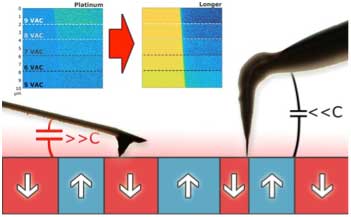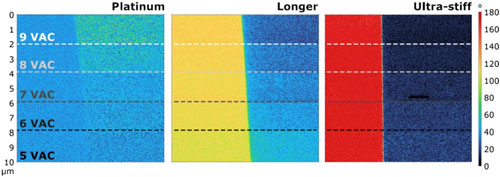| Posted: Jan 26, 2018 |
New technology aiming to improve trueness in the piezoelectric microscopy characterization of ceramic materials
(Nanowerk News) A team of researchers from ICMAB has proved that unconventional AFM probes are suitable to acquire a trueness piezoelectric signal in Piezoresponse Force Microscopy. The work entitles “Diminish electrostatic in piezoresponse force microscopy through longer or ultra-stiff tips” published in the prestigious scientific journal Applied Surface Science ("Diminish electrostatic in piezoresponse force microscopy through longer or ultra-stiff tips").
|
 |
| Figure 1: Side view of the two types of AFM probes used. The one at the right is a ultra-long tip which diminish the electrostatic interaction between the cantilever and the sample. Compared to the standard tip-which is images at the right side, the taller tip provides a cleaner piezoresponse signal in order to acquire the piezoelectric response of the material.
|
|
Piezoresponse Force Microscopy is a strongly used characterization technique in the world of piezoelectrics. Each year almost 300 manuscripts included this technique in their research, while piezoelectric community publishes more than 5000 papers yearly.
|
 |
| Figure 3: This figure denoted the number of manuscripts published per natural year with keywords “PFM”, left, and “PIEZOELECTRIC” right. Source: WoS
|
|
In this work researchers test almost every single AFM conductive probe available in the market using a novel method that quantifies the electrostatic contribution in their measurements. The method relies into solving the mathematical expression called “correlation function” that describes the mathematical operations that a lock-in amplifier performs to acquire the signals. After the theoretical description, the same sample is studies with different AFM tips available in the market, through the use of two distinct type of tests.
|
|
In the first test, the researchers increment the piezoelectric signal, while maintaining constant the electrostatic contribution. By doing this, the mount of signal coming from piezoelectricity increases, and hence, the changes in the final results a dramatically different. From this test, it is found that longer tips provide the cleaner signal from the overall set of probes used. These results are confirmed through the use of independent experiments that corroborates the first results.
|
 |
| Figure 2: Comparison of the piezoelectric signal acquired with different probes tests. In these images the highest the contrast the better. It is seen that longer and ultra-stiff tips provides the very best signal of the overall commercially available tips.
|
|
The implementation of this solution to the worldwide scientific community is immediate and can be used in absolutely any AFM manufacturer, which expands the importance and implications of this research.
|



